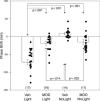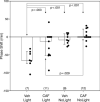Drugs that prevent mouse sleep also block light-induced locomotor suppression, circadian rhythm phase shifts and the drop in core temperature
- PMID: 24056197
- PMCID: PMC3864681
- DOI: 10.1016/j.neuroscience.2013.09.025
Drugs that prevent mouse sleep also block light-induced locomotor suppression, circadian rhythm phase shifts and the drop in core temperature
Abstract
Exposure of mice to a brief light stimulus during their nocturnal active phase induces several simultaneous behavioral or physiological responses, including circadian rhythm phase shifts, a drop in core body temperature (Tc), suppression of locomotor activity and sleep. Each response is triggered by light, endures for a relatively fixed interval and does not require additional light for expression. The present studies address the ability of the psychostimulant drugs, methamphetamine (MA), modafinil (MOD) or caffeine (CAF), to modify the light-induced responses. Drug or vehicle (VEH) was injected at CT11 into constant dark-housed mice then exposed to 5-min 100μW/cm(2) light or no light at CT13. Controls (VEH/Light) showed approximately 60-min phase delays. In contrast, response was substantially attenuated by each drug (only 12-15min delays). Under a 12-h light:12-h dark (LD12:12) photoperiod, VEH/light-treated mice experienced a Tc drop of about 1.3°C coincident with locomotor suppression and both effects were abolished by drug pre-treatment. Each drug elevated activity during the post-injection interval, but there was also evidence for CAF-induced hypoactivity in the dark prior to the photic test stimulus. CAF acutely elevated Tc; MA acutely lowered it, but both drugs reduced Tc during the early dark (ZT12.5-ZT13). The ability of the psychostimulant drugs to block the several effects of light exposure is not the result of drug-induced hyperactivity. The results raise questions concerning the manner in which drugs, activity, sleep and Tc influence behavioral and physiological responses to light.
Keywords: 12-h light:12-h dark; ANOVA; CAF; DA; DD; DMSO; DSI; Data Sciences International; IP; LD12:12; LED; MA; MOD; SCN; SNK; Student–Newman–Keuls; Tc; VEH; analysis of variance; arousal; caffeine; circadian; constant dark; core body temperature; dimethyl sulfoxide; dopamine; intraperitoneal; light emitting diodes; masking; methamphetamine; modafinil; photosomnolence; suprachiasmatic; suprachiasmatic nucleus; thermoregulation; vehicle.
Copyright © 2013 IBRO. Published by Elsevier Ltd. All rights reserved.
Figures







Similar articles
-
Sleep Deprivation and Caffeine Treatment Potentiate Photic Resetting of the Master Circadian Clock in a Diurnal Rodent.J Neurosci. 2017 Apr 19;37(16):4343-4358. doi: 10.1523/JNEUROSCI.3241-16.2017. Epub 2017 Mar 20. J Neurosci. 2017. PMID: 28320839 Free PMC article.
-
Light pulse duration differentially regulates mouse locomotor suppression and phase shifts.J Biol Rhythms. 2014 Oct;29(5):346-54. doi: 10.1177/0748730414547111. Epub 2014 Sep 17. J Biol Rhythms. 2014. PMID: 25231948
-
Effects of light, food, and methamphetamine on the circadian activity rhythm in mice.Physiol Behav. 2014 Apr 10;128:92-8. doi: 10.1016/j.physbeh.2014.01.021. Epub 2014 Feb 11. Physiol Behav. 2014. PMID: 24530262
-
Nocturnal light and nocturnal rodents: similar regulation of disparate functions?J Biol Rhythms. 2013 Apr;28(2):95-106. doi: 10.1177/0748730413481921. J Biol Rhythms. 2013. PMID: 23606609 Review.
-
Genetics and functional significance of the understudied methamphetamine sensitive circadian oscillator (MASCO).F1000Res. 2022 Sep 8;11:1018. doi: 10.12688/f1000research.125432.2. eCollection 2022. F1000Res. 2022. PMID: 36226037 Free PMC article. Review.
Cited by
-
Modification of 5-methoxy-N,N-dimethyltryptamine-induced hyperactivity by monoamine oxidase A inhibitor harmaline in mice and the underlying serotonergic mechanisms.Pharmacol Rep. 2016 Jun;68(3):608-15. doi: 10.1016/j.pharep.2016.01.008. Epub 2016 Feb 5. Pharmacol Rep. 2016. PMID: 26977821 Free PMC article.
-
Precision caffeine therapy for apnea of prematurity and circadian rhythms: New possibilities open up.Front Pharmacol. 2022 Dec 1;13:1053210. doi: 10.3389/fphar.2022.1053210. eCollection 2022. Front Pharmacol. 2022. PMID: 36532766 Free PMC article. Review.
-
Sweetened caffeine drinking revealed behavioral rhythm independent of the central circadian clock in male mice.NPJ Sci Food. 2024 Aug 19;8(1):51. doi: 10.1038/s41538-024-00295-6. NPJ Sci Food. 2024. PMID: 39160163 Free PMC article.
-
Effects of chronic caffeine consumption on sleep and the sleep electroencephalogram in mice.J Psychopharmacol. 2019 Jan;33(1):122-131. doi: 10.1177/0269881118806300. Epub 2018 Oct 24. J Psychopharmacol. 2019. PMID: 30354930 Free PMC article.
-
Effects of caffeine on circadian phase, amplitude and period evaluated in cells in vitro and peripheral organs in vivo in PER2::LUCIFERASE mice.Br J Pharmacol. 2014 Dec;171(24):5858-69. doi: 10.1111/bph.12890. Epub 2014 Nov 24. Br J Pharmacol. 2014. PMID: 25160990 Free PMC article.
References
-
- Antle MC, Steen NM, Mistlberger RE. Adenosine and caffeine modulate circadian rhythms in the Syrian hamster. Neuroreport. 2001;12:2901–2905. - PubMed
-
- Aschoff J, Daan S, Honma K-I. Zeitgebers, entrainment, and masking: some unsettled questions. In: Aschoff J, Daan S, Groos GA, editors. Vertebrate Circadian Rhythms. Springer-Verlag; New York: 1982. pp. 13–21.
-
- Brown CM, Refinetti R. Daily rhythms of metabolic heat production, body temperature, and locomotor activity in golden hamsters. J Therm Biol. 1996;21:227–230.
-
- Daan S, Pittendrigh CS. A functional analysis of circadian pacemakers in nocturnal rodents. II. The variability of phase response curves. J Comp Physiol A. 1976;106:253–266.
-
- Dahan L, Astier B, Vautrelle N, Urbain N, Kocsis B, Chouvet G. Prominent burst firing of dopaminergic neurons in the ventral tegmental area during paradoxical sleep. Neuropsychopharmacology. 2007;32:1232–1241. - PubMed
Publication types
MeSH terms
Substances
Grants and funding
LinkOut - more resources
Full Text Sources
Other Literature Sources

